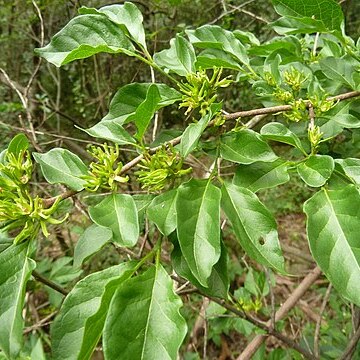A small shrub or tree. It can be 13 m high. The bark is light grey. There are often spines at the ends of branches. The leaves are opposite and simple. They are oval and 3.5-14 cm long by 2.5-8 cm wide. They taper to both ends. Leaves are often unequal in the two halves. The leaf stalk can be 10 mm long. Leaves are larger and less hairy when growing in forest. Flowers are greenish-yellow. They are 1-1.5 cm across. The flowers occur in clusters in the axils of leaves. The fruit are oval and fleshy. They are 2 cm long. There are ridges long the fruit dividing them into 3-5 lobes. They are yellow-orange when mature. There is a strap-like calyx at the tip. The fruit are edible.
Small tree or shrub, up to 2.5 m high. Leaves velvety, coriaceous, (20-)25-45(-50) x (15-)18-25(-30) mm, broadly elliptic to round. Peduncle 0-3 mm long. Calyx lobes 7-8 mm long, velvety. Flowers greenish.


